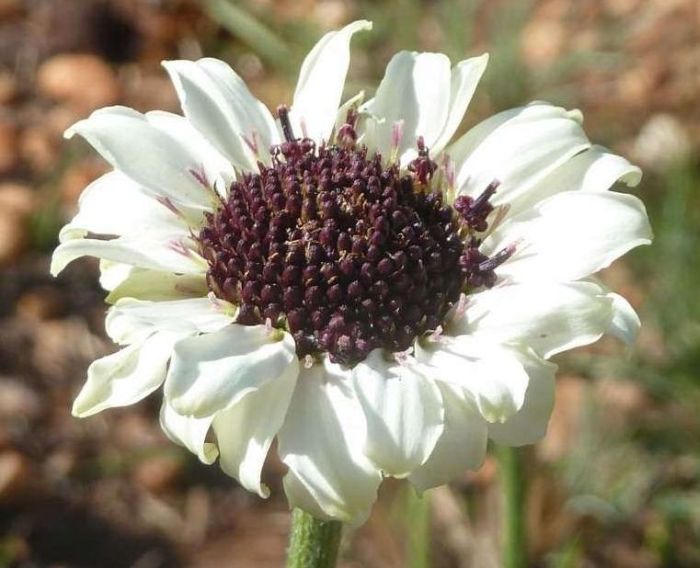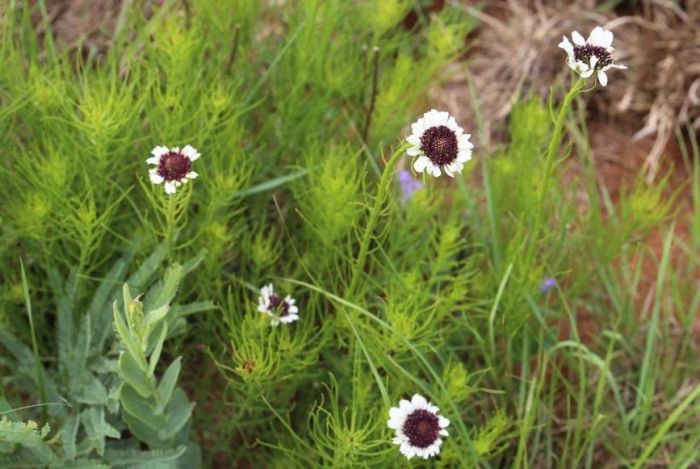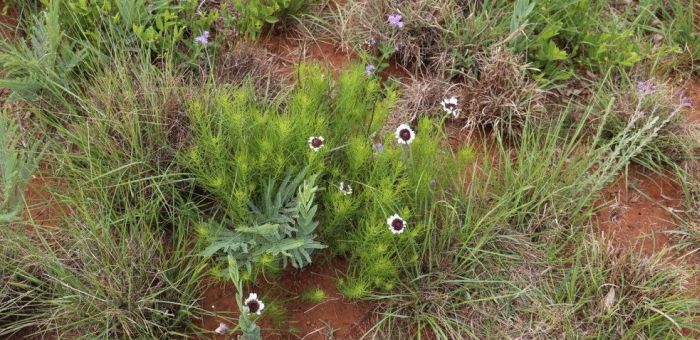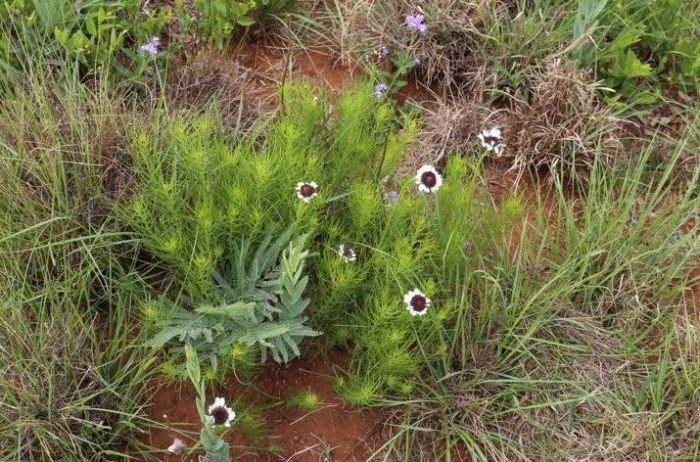Callilepis leptophylla
Callilepis leptophylla Harv.
Family: Asteraceae
Common names: wild daisy (Eng.); bergbitterbossie (Afr.); imphila (siSwati)
Introduction
An aromatic perennial herb with needle-like leaves and large flowers early in the season, and it mixes well with grasses.

Description
Description
Callilepis leptophylla is an aromatic perennial herb that grows up to 600 mm high. Its stem arises from a large woody rootstock, glabrous in the lower parts. Leaves and younger branches are often softly villose and closely arranged together at the apices. Its leaves are alternate, linear and needle-like, up to 45 mm long, single-nerved. It has large flowerheads, with cream-white rays and a purplish black disc. It flowers in spring and early summer (September to January), starting early in the season when not many other perennials are in flower.

Conservation Status
Status
Callilepis leptophylla is assessed as Least Concern (LC) according to the Red List of South African plants. However, its wild population is decreasing. Once a widespread species, it is declining in the wild. The extent of the decline is unknown, but not severe enough to warrant being listed as threatened.
Distribution and habitat
Distribution description
Callilepis leptophylla is widespread in the eastern part of South Africa, in the provinces of Gauteng, KwaZulu-Natal, Limpopo and Mpumalanga, and it also occurs in parts of Swaziland. It grows amongst the grasses in grassland and in open woodland, often on rocky slopes.

Derivation of name and historical aspects
History
The genus name Callilepis is derived from the Greek words kallos, meaning ‘beauty’, and lepis, meaning ‘scale’. The specific epithet, leptophylla comes from the Greek words leptos, meaning ‘slender’ or ‘thin’ and phyllon, meaning ‘leaf’.
Ecology
Ecology
Wild daisy seeds are dispersed by insects, birds, wind and rain. Its beautiful flowerheads attract insects and bees for pollination.
Uses
Use
Callilepis leptophylla roots are used to kill maggots in cattle. The rootstock is toxic if eaten.

Growing Callilepis leptophylla
Grow
Callilepis leptophylla can be planted in the garden in a sunny position in well-drained soil, with moderate water in spring and summer. It is well suited to grassland gardens and rockeries.
Propagate by seed sown as soon as it is ripe, in a free-draining, sandy seedling mix, cover lightly, keep moist, and place in a sunny, well-ventilated place. Seed is ready for harvesting when it comes off easily in your fingers.
Callilepis plants are deciduous, dying back in the winter months and resprouting in the spring.
References
- Claassen, C. 1969. Callilepis leptophylla. Flowering Plants of Africa 39: t. 1554.
- Germishuizen, G. & Fabian, A. 1997. Wild flowers of northern South Africa. Fernwood Press, Vlaeberg, Cape Town.
- Hilton-Taylor, C. 1996. Red Data List of Southern African Plants. National Botanical Institute, Pretoria
- Long, C. 2005. Swaziland’s flora – siSwati Names and Uses. http://www.sntc.org.sz/flora/clbotalpha.asp?l=A
- Marimuthoo, D. 2008. Callilepis laureola D.C. PlantZAfrica. Online. http://pza.sanbi.org/callilepis-laureola.
- Retief, E. & Herman, P.P.J. 1997. Plants of the northern provinces of South Africa: keys and diagnostic characters. Strelitzia 6. National Botanical Institute, Pretoria.
- Swanepoel, D.P. 1997. The medicinal value of the southern African Asteraceae. M.Sc. dissertation. Pretoria: University of Pretoria. South Africa: 116.
- Victor, J.E. 2016. Callilepis leptophylla Harv. National Assessment: Red List of South African plants version 2017.1. Accessed on 2019/10/09.
Credits
Thabo Thomas Masupa
National Herbarium, Pretoria
October 2019
Acknowledgements: my sincere thanks goes to Fergy Nkadimeng, Alec Naidoo and Andrew Hankey for capturing the images of Callilepis leptophylla used in this article and also to Paul Herman for providing the literature.
Plant Attributes:
Plant Type: Perennial
SA Distribution: Gauteng, KwaZulu-Natal, Limpopo, Mpumalanga
Soil type: Sandy, Loam
Flowering season: Spring, Early Summer
PH:
Flower colour: Black, Purple, White, Cream
Aspect: Full Sun
Gardening skill: Average
Special Features:
Horticultural zones









Rate this article
Article well written and informative
Rate this plant
Is this an interesting plant?
Login to add your Comment
Back to topNot registered yet? Click here to register.